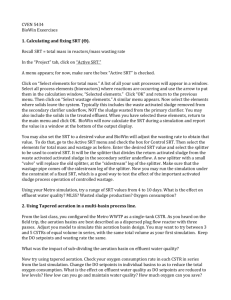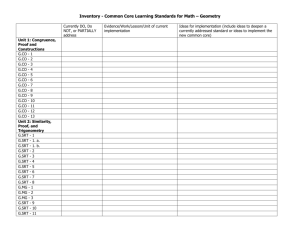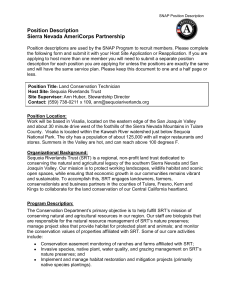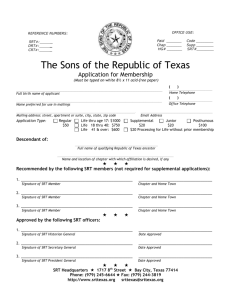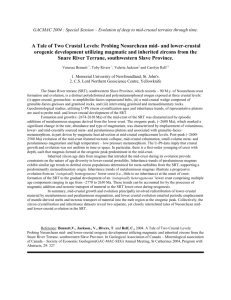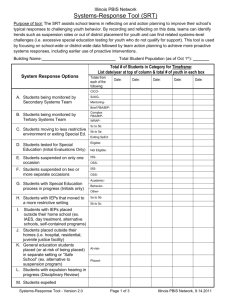Supplementary Information (doc 870K)
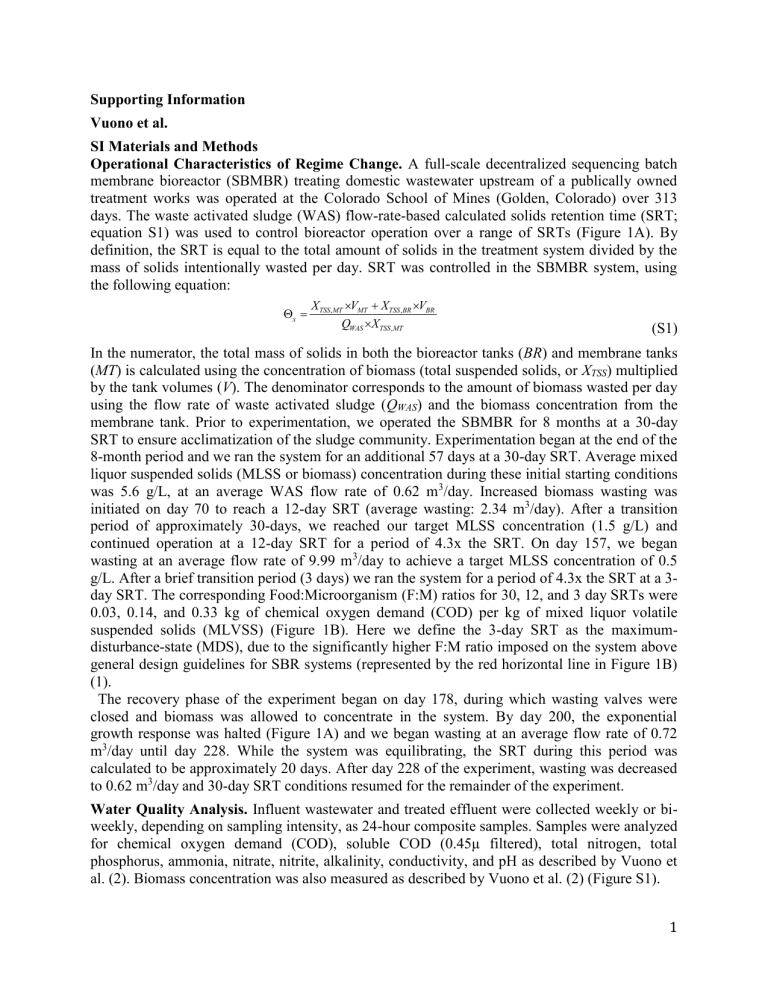
Supporting Information
Vuono et al.
SI Materials and Methods
Operational Characteristics of Regime Change. A full-scale decentralized sequencing batch membrane bioreactor (SBMBR) treating domestic wastewater upstream of a publically owned treatment works was operated at the Colorado School of Mines (Golden, Colorado) over 313 days. The waste activated sludge (WAS) flow-rate-based calculated solids retention time (SRT; equation S1) was used to control bioreactor operation over a range of SRTs (Figure 1A). By definition, the SRT is equal to the total amount of solids in the treatment system divided by the mass of solids intentionally wasted per day. SRT was controlled in the SBMBR system, using the following equation:
Q x
=
X
TSS , MT
×
V
MT
+
X
TSS , BR
Q
WAS
×
X
TSS , MT
×
V
BR
(S1)
In the numerator, the total mass of solids in both the bioreactor tanks ( BR ) and membrane tanks
( MT ) is calculated using the concentration of biomass (total suspended solids, or X
TSS
) multiplied by the tank volumes ( V ). The denominator corresponds to the amount of biomass wasted per day using the flow rate of waste activated sludge ( Q
WAS
) and the biomass concentration from the membrane tank. Prior to experimentation, we operated the SBMBR for 8 months at a 30-day
SRT to ensure acclimatization of the sludge community. Experimentation began at the end of the
8-month period and we ran the system for an additional 57 days at a 30-day SRT. Average mixed liquor suspended solids (MLSS or biomass) concentration during these initial starting conditions was 5.6 g/L, at an average WAS flow rate of 0.62 m
3
/day. Increased biomass wasting was initiated on day 70 to reach a 12-day SRT (average wasting: 2.34 m
3
/day). After a transition period of approximately 30-days, we reached our target MLSS concentration (1.5 g/L) and continued operation at a 12-day SRT for a period of 4.3x the SRT. On day 157, we began wasting at an average flow rate of 9.99 m
3
/day to achieve a target MLSS concentration of 0.5 g/L. After a brief transition period (3 days) we ran the system for a period of 4.3x the SRT at a 3day SRT. The corresponding Food:Microorganism (F:M) ratios for 30, 12, and 3 day SRTs were
0.03, 0.14, and 0.33 kg of chemical oxygen demand (COD) per kg of mixed liquor volatile suspended solids (MLVSS) (Figure 1B). Here we define the 3-day SRT as the maximumdisturbance-state (MDS), due to the significantly higher F:M ratio imposed on the system above general design guidelines for SBR systems (represented by the red horizontal line in Figure 1B)
(1).
The recovery phase of the experiment began on day 178, during which wasting valves were closed and biomass was allowed to concentrate in the system. By day 200, the exponential growth response was halted (Figure 1A) and we began wasting at an average flow rate of 0.72 m
3
/day until day 228. While the system was equilibrating, the SRT during this period was calculated to be approximately 20 days. After day 228 of the experiment, wasting was decreased to 0.62 m
3
/day and 30-day SRT conditions resumed for the remainder of the experiment.
Water Quality Analysis.
Influent wastewater and treated effluent were collected weekly or biweekly, depending on sampling intensity, as 24-hour composite samples. Samples were analyzed for chemical oxygen demand (COD), soluble COD (0.45µ filtered), total nitrogen, total phosphorus, ammonia, nitrate, nitrite, alkalinity, conductivity, and pH as described by Vuono et al. (2). Biomass concentration was also measured as described by Vuono et al. (2) (Figure S1).
1
PCR. PCR reactions were carried out in a total reaction volume of 25 µL, 2 µl of which was
DNA template. In order to minimize primer dimer formation, we employed a PCR-touchdown annealing temperature strategy for the first 10 cycles from 68-58° C, proceeded by 10 cycles of three-step PCR (denaturation, annealing, elongation) followed by an additional number of cycles, which was determined by the start PCR-plateau phase, as measured by quantitative PCR (qPCR) of two-step PCR (annealing and elongation at same temperature). Reagents and final concentrations were 1x Phusion HF polymerase (2X mastermix) with 8% v/v DMSO and 0.5 uM forward and reverse primers in the final reaction volume. PCR products were quantified using the NanoDrop Spectrophotometer ND-1000 (Wilmington, DE) as well as gel quantification for redundancy. Amplicons were gel purified using the E.N.Z.A. gel purification kit (Omega).
Briefly, the SSU rRNA gene primers used were 515f-modified, 5’-
GTGYCAGCMGCCGCGGTAA-3’, and 927r-modified, 5’-CCGYCAATTCMTTTRAGTTT-
3’.
SSU rRNA Processing Pipeline and Quality Control. Flowgrams were denoised using
DeNoiser version 1.3.0-dev, loaded from the QIIME 1.5.0 Amazon machine identifier (AMI), on
Amazon Web Services (AWS) eight-core m2.4xlarge EC2 instance, launched as a 20-node cluster via StarCluster ( http://star.mit.edu/cluster/index.html
). Chimeric sequences were identified using UCHIME (USEARCH version 6.0.203) under reference mode and de novo mode
(3). Given that chimeric sequences are most likely less abundant sequences, the most abundant sequences of cluster sizes >20 that were flagged as chimeras were hand-checked against the
NCBI nt database using BLAST (4). Query sequences with ≤ 99% identity and mismatches on either end of the reference sequence were split at the point where reference and query sequence appeared to diverge. Each end of the split sequence was re-BLASTed and taxonomic consistency was inspected between either end’s best BLAST hit. Sequences that did not meet the above requirements were discarded.
We aligned DNA sequences to the SILVA bacterial reference Seed alignment
( www.mothur.org
) using NAST (5); those sequences that did not begin at the V4 region and terminate at the end of the V5 region were discarded from further analysis. Vertical gaps were removed from the alignment and leading and trailing columns were discarded such that no sequences had terminal gaps (vertical=T and trump=., options in Mothur). Taxonomic classification of all remaining sequences was implemented using the RDP Classifier (6) at 80% bootstrap confidence against the Greengenes 16S rRNA database (13_5 release) (7). Sequences were clustered into operational taxonomic units (OTUs) at 97% identity using the average neighbor method (Mothur) with pairwise distances calculated from the multiple sequence alignment described above. The consensus taxonomy was assigned to OTU clusters using the
‘classify.otu()’ command in Mothur.
Data Analysis. Pairwise community similarity of Weighted Unifrac (8) and Morisita-Horn indices were computed in QIIME using the ‘alpha_diversity.py’ script. To determine whether
SRTs contained differences in species and phylogenetic composition, ANOSIM and ADONIS with 999 permutations were used to test significant differences between groups based on weighted UniFrac and Morisita-Horn indices.
Taxonomy-based Hill number calculations were carried out using custom R scripts and in the vegan package (9) and plotted using ggplot2 (10) within the R environment for statistical computing ( http://www.r-project.org/ ). Hill numbers based on phylogenetic diversity were calculated using custom R scripts by Armitage et al., using the following equation:
2
q
D
Z
( ) =
æ
ç
ç
å
p i , b : i p
Î
( i , b )
I
> b
,
0
( i , b )
( ) q
-
1
( i , b )
ö
÷
÷ q /(1
q )
(S2) where
π
(i,b)
is the relative abundance of internal branches in a phylogenetic tree, or “historical species” ( i,b ), for each branch b of i
∈
{1, 2, 3,. . ., S }, I b
⊆ {1, 2, 3,. . ., S } that have descended from b , and Z
(I,b)(j,c)
is an asymmetric relatedness matrix (see Leinster & Cobbold Appendix A for Mathematical Proofs). At 0 DZ (
π
), Z is equal to I (identity matrix), which is the species richness of the community. For each sludge sample,
qDZ
(
π
) values were calculated over a range of q (0–5) averaged over 100 subsamples and rarefied to the smallest number of sequences in each sample. The R code used to calculate diversity profiles can be downloaded at https://gist.github.com/darmitage.
In order to test if diversity recovered after disturbance, the time series was modeled as an AR(1) process. We observe proportions of various OTUs at times t
1
, ..., t n
. Let x i be the number of sequences in a particular OTU at time t i
. Between t i and t i+1 each organism produces a clone of a random size (if the organism dies the clone size is 0). We assume the clone sizes of the organisms are independent and identically distributed. The number of copies x i+1 at time t i+1 is the sum of the clone sizes plus immigration. By the previous assumption the sum of the clone sizes will be approximately normally distributed. The distribution of x i+1 depends on x i
.
However, if x i we model x i is known, no further information about x i+1 can be obtained from x as a Gaussian AR(1) time series. We compute the proportion p i i-1
. Therefore by dividing x i by the total number of organisms at time t i
. We expect that the Gaussian AR(1) property will be preserved for each p i
. Then we compute the Hill number q=1. Since this is a differentiable function of proportions, we again expect that the Gaussian AR(1) property will be preserved.
We considered four stages:
1) 30-day SRT: Days 1, 10, 19, 30, 43, 52
2) 12-day SRT: Days 108, 127, 138, 149
3) 3-day SRT: Days 165, 169, 177
4) 30-day SRT: Days 243, 256, 270, 284, 298, 312
We did not consider measurements made during the transitions between SRTs. We assumed that measurements in distinct stages are independent.
SI Results
This study adds to the current body of research through an investigation of the diversity, composition, and dynamics of activated sludge bacterial communities under different operational conditions with culture-independent SSU-rRNA sequence surveys coupled with process performance. Using wastewater treatment systems for whole-ecosystem manipulations has several advantages: 1) environmental and chemical parameters, such as temperature, pH, dissolved oxygen, and salinity, are more tightly constrained and controlled within engineered systems; 2) the use of real wastewater provides a discrete immigration source to account for dispersal assembly mechanisms (11–13); and 3) ecosystem processes are well-defined based on decades of environmental engineering research and development. In the latter, nutrients (e.g., ammonia and phosphorus) and carbon enter a treatment plant and must be removed by a consortium of microorganisms that perform discrete ecosystem functions such as carbon oxidation, nitrification/denitrification, and phosphorus removal, with additional benefits of some
3
micropollutant removal (e.g., personal care products, caffeine, endocrine disruptors, and medicines) at higher SRTs. Thus, the recovery of ecosystem functions after a disturbance can be accurately measured by nutrient removal efficiency in addition to the ecological response of the microbial diversity and community structure. The Colorado School of Mines SBMBR has the added advantage of being a full-scale wastewater treatment facility upstream of a municipal treatment plant that allows for full-scale experimentation and manipulation without the worry of meeting discharge standards.
In Figure S1, bioreactor performance parameters are plotted versus time. During the MDS, effluent alkalinity reaches comparable values as the influent, which indicates that nitrification in no longer occurring in the bioreactor. Effluent conductivity also reaches comparable values to the influent, which indicates that sorption of mono and divalent cations, such as sodium, potassium, calcium, and magnesium, to the activated sludge floc has been reduced from operation at lower sludge concentrations. Drops in pH at the beginning of the study caused an increase in effluent nitrate, but recovered quickly once pH was restored to normal operating conditions. After the MDS and biomass recovery period on day 235 of the experiment, new ultrafiltration membrane cassettes (0.05µm nominal pore size) were installed because irreversible membrane fouling was observed. Typically, membrane bioreactors are operated at SRTs >8 days. For this study, the use of the membrane bioreactor was intended for filtration purposes and ease of operation. The sharp decrease in transmembrane pressure (TMP) on day 235 indicates the membrane replacement. Also, upward trends in TMP followed by a sharp decline indicate when chemical maintenance cleaning was conducted, as described by Vuono et al. In addition, while the treatment plant was operated inside of an insulated building, a decrease in water temperature was observed, coinciding with the winter season. The lowest drop in temperature occurred several weeks before the initiation of the 3-day SRT (MDS) and thus does not explain the major shifts in community composition that were observed during the MDS. These results are also supported by effects of temperature on microbial composition in other full-scale activated sludge systems (14).
SI References
1. Tchobanoglous, G., Burton, F., Stensel D (2003) Wastewater Engineering; Treatment and
Reuse (McGraw-Hill Inc., New York). 4th Ed.
2. Vuono D et al. (2013) Flexible hybrid membrane treatment systems for tailored nutrient management: A new paradigm in urban wastewater treatment. J Memb Sci 446:34–41.
3. Edgar RC, Haas BJ, Clemente JC, Quince C, Knight R (2011) UCHIME improves sensitivity and speed of chimera detection. Bioinformatics 27:2194–200.
4. Altschul SF, Gish W, Miller W, Myers EW, Lipman DJ (1990) Basic Local Alignment
Search Tool. J Mol Biol 215:403–410.
5. DeSantis TZ et al. (2006) NAST: a multiple sequence alignment server for comparative analysis of 16S rRNA genes. Nucleic Acids Res 34:394–399.
6. Wang Q, Garrity GM, Tiedje JM, Cole JR (2007) Naive Bayesian classifier for rapid assignment of rRNA sequences into the new bacterial taxonomy. Appl Environ Microbiol
73:5261–7.
7. DeSantis TZ et al. (2006) Greengenes, a chimera-checked 16S rRNA gene database and workbench compatible with ARB. Appl Environ Microbiol 72:5069–72.
8.
Lozupone C, Knight R (2005) UniFrac : a New Phylogenetic Method for Comparing
Microbial Communities. Society 71:8228–8235.
4
9. Oksanen AJ et al. (2012) Vegan: community ecology package. Compute .
10. Wickham H (2009) ggplot2: elegant graphics for data analysis.
11. Curtis TP, Sloan WT (2006) Towards the design of diversity: stochastic models for community assembly in wastewater treatment plants. Water Sci Technol 54:227.
12. Hubbell SP (2001) The Unified Neutral Theory of Biodiversity and Biogeography
(Princton University Press, Princton, NJ, USA)
13. Sloan WT et al. (2006) Quantifying the roles of immigration and chance in shaping prokaryote community structure. Environ Microbiol 8:732–40.
14. Wells GF, Park H-D, Eggleston B, Francis C a, Criddle CS (2011) Fine-scale bacterial community dynamics and the taxa-time relationship within a full-scale activated sludge bioreactor. Water Res 45:5476–5488.
Figure S1. Operations summary throughout time-course showing vital operational, chemical and environmental parameters by location. Return activated sludge (RAS)
5
measurements were taken by submerged probes in the RAS trough as described by Vuono et al.
Figure S2. Dynamics of nitrogen species in treated effluent during the maximum disturbance state (MDS), and recovery periods. Cyclical pattern of online nitrate probe
(green line) indicate daily fluctuations of influent ammonia manifested as effluent nitrate.
6
Figure S3. Principal coordinate analysis of (A) Bray-Curtis dissimilarities, (B) Morisita-
Horn distances, and (C) Unweighted UniFrac distances of sludge samples by SRTs and transition periods.
7
Figure S4. Principal coordinate analysis of weighted UniFrac distances between samples and through time.
Figure S5. Relative abundance of bacterial orders within Alphaproteobacteria through time. MDS and Biomass recovery periods occur between days 157 and 200.
Error bars represent the standard error of the sample mean.
8
Figure S6. Relative abundance of genus-level Nitrosomonas OTUs (4 total) through time.
MDS and Biomass recovery periods occur between days 157 and 200.
Error bars represent the standard error of the sample mean.
Table S1. Summary of percent removal ± standard deviation for COD, total nitrogen, and total phosphorus for each SRT.
Parameter
Removal %
COD
Total N
Total P
30 day SRT 12 Day SRT 3 Day SRT
Post Recovery 30
Day SRT
96.3±0.9 (n=14)
97.9±1.1 (n=11)
95.1±2.4 (n=6)
94.2±3.4 (n=7) 83.4±6.1 (n=12) 46.1±15.8 (n=6)
95.6±0.8 (n=11)
91.5±3.3 (n=11)
95.2±15.1 (n=8) 50.2±9.2 (n=12) 38.9±19.2 (n=6) 89.8±13.8 (n=11)
9
